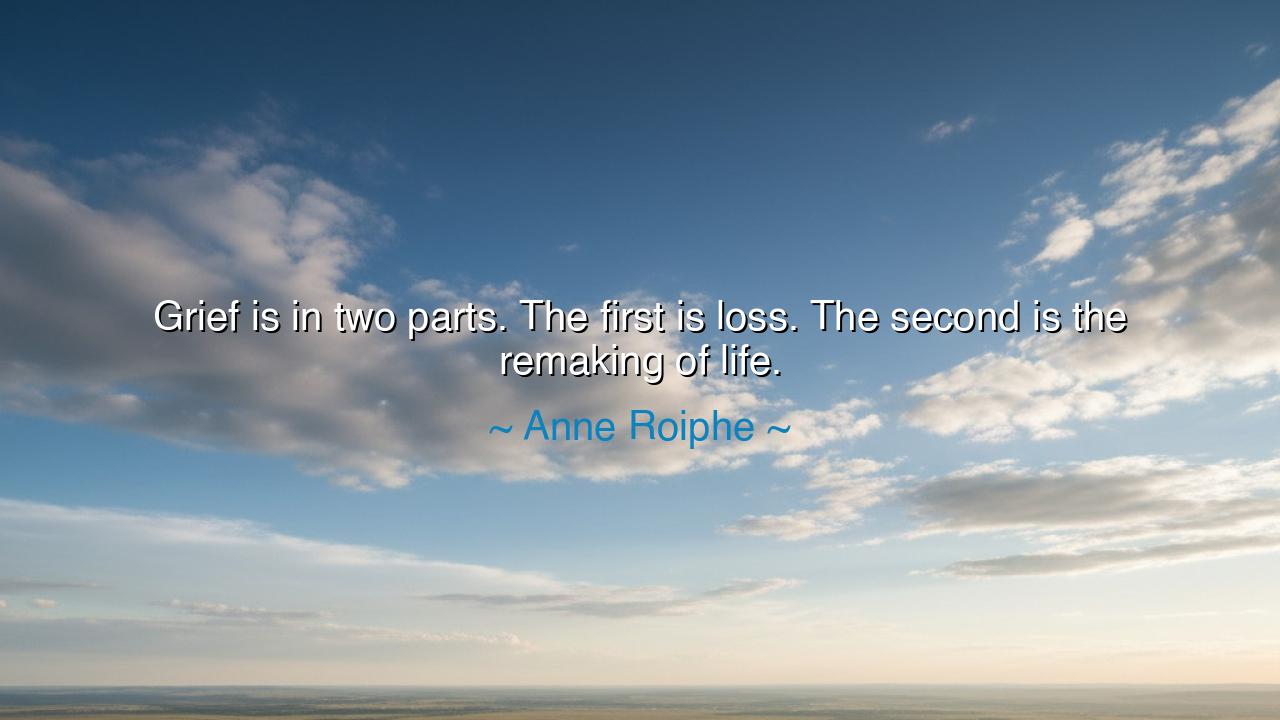
Grief is in two parts. The first is loss. The second is the






“Grief is in two parts. The first is loss. The second is the remaking of life.” Thus speaks Anne Roiphe, capturing in simple words a truth as old as the human heart. For grief is not a single blow but a journey—first the shattering of what was, then the slow and painful weaving of what must come. The ancients, too, knew this: that mourning is both descent and ascent, the plunge into sorrow and the climb toward renewal. To lose is to be broken; to remake is to rise from the shards, shaping a new vessel for the soul.
The first part is loss. It strikes like a storm, sudden and merciless. A loved one is taken, a dream collapses, a bond is severed. In that moment the world seems hollow, stripped of color and meaning. Loss is the tearing away of what the heart clung to, and in its wake comes silence, shock, and emptiness. This is the beginning of grief—the darkness that descends and the void that seems unending. None escape it, for to live and to love is to one day lose.
But Roiphe reminds us of the second part: the remaking of life. Though the wound of loss never wholly vanishes, life does not end with it. Slowly, painfully, we begin to stitch new patterns into our days. We carry the memory of what is gone, but we also learn to walk with it, shaping our existence around the absence. This is no betrayal of the lost, but a testimony to their impact—that life, altered forever, continues, and in continuing, honors them. The remaking is the work of the living, a sacred duty to oneself and to those who came before.
Consider the life of C.S. Lewis, who after the death of his beloved wife Joy, was plunged into despair. He wrote in A Grief Observed of the searing emptiness, the first part of grief—loss. Yet in time, though scarred, he began to rebuild, carrying her memory into his writings, allowing her love to reshape his understanding of faith and humanity. His remade life did not erase the pain, but transformed it into wisdom that still speaks to generations. In him, we see both parts of grief: the breaking and the remaking.
The ancients, too, carved this wisdom into their myths. From the ashes of the phoenix comes new flight; from Persephone’s descent into the underworld comes the renewal of spring. Loss and remaking are woven into the very fabric of existence. The tree loses its leaves in winter, yet is remade in spring. The heart loses what it loves, yet finds ways to bloom again. To deny this cycle is to deny life itself.
O children of tomorrow, do not fear grief as an endless night. Know that its first part, loss, is cruel and unavoidable. But know also that its second part, remaking, waits beyond the shadow. You are not called to forget, nor to erase the wound, but to rise with it, to reshape your days, to find meaning anew. For the measure of your strength is not only how you endure loss, but how you live after it.
The lesson is clear: grief is not only an ending, but also a beginning. Practically, let each person do this: when loss comes, give yourself to mourning, for the first part must be endured. Do not rush it. But in time, take small steps toward the remaking—build new routines, create new rituals of remembrance, speak the name of the one you lost with both tears and gratitude. In doing so, you weave sorrow into life, and life into strength.
Thus remember Roiphe’s words: “Grief is in two parts. The first is loss. The second is the remaking of life.” Carry them as a lantern in dark times. For though grief wounds, it also teaches; though it breaks, it also builds. And the one who accepts both parts will emerge not unscarred, but transformed, bearing the quiet, eternal strength of one who has remade life from the ruins of loss.






AAdministratorAdministrator
Welcome, honored guests. Please leave a comment, we will respond soon